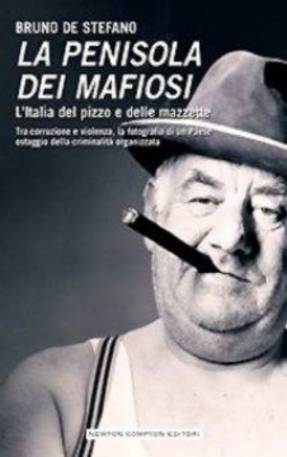


“What’s with you guys named De Stefano writing about the mafia?”
So joked my cyberpal Francesco Raffaele Armando Pepe, in an e-mail he sent to tell me about a new book, “La penisola dei mafiosi: L’Italia del pizzo e delle mazzette” (The Peninsula of Mafiosi: The Italy of Protection Money and Bribes), by a Neapolitan journalist named Bruno De Stefano.
Francesco, whose family migrated to Amsterdam from Naples (See Joey Skee’s “Francesco Pepe: My Dutch Paisan” [2] ) is an amazing fount of information about Italian organized crime and its cultural representations, in film, literature, and music. He generously shares his findings, too. He’s sent me DVDs of films that have not been distributed in America, such as Francesco Patierno’s “Paterfamilias,” a scalding critique of male violence and misogyny, and CDs by Pino Mauro, a popular Neapolitan singer-actor known for his guappo (gangster) film roles.
So when Francesco told me about Bruno De Stefano, I knew I had to check out this writer with the same cognome as mine.
It turns out that De Stefano, 42, is one of Naples’ leading anti-Mafia journalists, along with the internationally known Roberto Saviano, Rosaria Capacchione (who, like Saviano, is under 24-hour police protection) and the venerable Giorgio Bocca. De Stefano has written for various daily newspapers, including Paese Sera, Il Giornale di Napoli, Corriere del Mezzogiorno (the Campania edition of Corriere della Sera) and the weekly, Metropolis. He currently edits City, a free weekly published by the Rizzoli-Corriere della Sera group.
Francesco Pepe linked Bruno and me as De Stefanos writing about organized crime. But Bruno writes actual exposés and analyses of crimine organizzata. In my book, “An Offer We Can’t Refuse: The Mafia in the Mind of America,” I examined the mythology of the Mafia, its cultural representations, in the context of Italian immigration to America and Italian American history. Needless to say, Bruno’s investigative reporting, from the ground zero of Neapolitan organized crime, is a far riskier and braver undertaking than my cultural criticism, written in the safety of my New York apartment.
Bruno De Stefano has written three books, each published (by Newton Compton) in the past three years: “Napoli Criminale” (Criminal Naples, 2006); “I Boss della Camorra” (Camorra Bosses, 2007) and “La penisola dei mafiosi: L'Italia del pizzo e delle mazzette” (2008). Of his most recent title, Roberto Saviano has said, “I have read Bruno De Stefano -- a sharp, clear, hard book.”
The reviewer for Il Corriere del Mezzogiorno called “Penisola” a “documented essay about the Italy of protection money and bribes, rigorously journalistic reportage about the infiltration of the mafias in the institutions of the Belpaese.”
Bruno, in a February 2009 interview with the daily Il Mattino, pulled no punches in his assessment of organized crime’s impact on Italy. He said that one of his aims in writing “La Penisula dei Mafiosi” was to “overturn the belief that the mafias represent a problem only for the South. Instead we face a plague of national dimensions that extends from Val d’Aosta to Lombardy, from Emilia Romagna to Lazio, down to Sicily.”
In his books and articles, De Stefano shows how this “plague” infects Italian society, reaching into businesses large and small and governmental agencies, including even public health boards.
De Stefano says the “macchina repressiva” – the Italian state’s anti-organized crime apparatus -- has functioned fairly well. “But in some areas, the situation is now compromised and the engagement of the magistrates and the forces of order, though solid, runs the risk of becoming ineffective.”
He also discussed a “Mafioso mentality,” saying that if Italy “had not been so extraordinarily permeable to the culture of “soprafazzione” (abuse of power), organized crime today would have far less influence and power.
Asked how Naples “lives” these days, De Stefano replied, “Naples doesn’t live, it endures. If we put aside our useless, parochial pride, we cannot but recognize that our city forces us to live as prisoners of fear. The fear of being robbed or being killed. And to realize that, apart from reading the daily newspaper accounts, all you have to do is glance at the list of innocent victims killed in the last years. Today few have remained to defend Naples. The only ones who do so are those who went to live elsewhere, like Sophia Loren, Pino Daniele, or [pop star] Gigi D’Alessio. But it’s easy, as well as comfortable, to defend Naples if you live in Los Angeles or in [the wealthy Roman neighborhood] Parioli.”
As Roberto Saviano says, sharp, clear, and hard.
Bruno De Stefano’s blog: http://brunodestefano.splinder.com/ [3]
Source URL: http://ftp.iitaly.org/magazine/focus/op-eds/article/due-de-stefano
Links
[1] http://ftp.iitaly.org/files/8506penisola1238718609jpg
[2] http://www.i-italy.org/bloggers/1977/francesco-pepe-my-dutch-paisan
[3] http://brunodestefano.splinder.com/